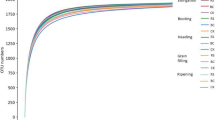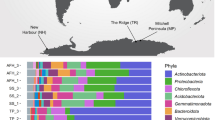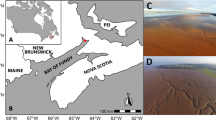Abstract
Ancient mariners knew that dust whipped up from deserts by strong winds travelled long distances, including over oceans. Satellite remote sensing revealed major dust sources across the Sahara. Indeed, the Bodélé Depression in the Republic of Chad has been called the dustiest place on earth. We analysed desert sand from various locations in Chad and dust that had blown to the Cape Verde Islands. High throughput sequencing techniques combined with classical microbiological methods showed that the samples contained a large variety of microbes well adapted to the harsh desert conditions. The most abundant bacterial groupings in four different phyla included: (a) Firmicutes—Bacillaceae, (b) Actinobacteria—Geodermatophilaceae, Nocardiodaceae and Solirubrobacteraceae, (c) Proteobacteria—Oxalobacteraceae, Rhizobiales and Sphingomonadaceae, and (d) Bacteroidetes—Cytophagaceae. Ascomycota was the overwhelmingly dominant fungal group followed by Basidiomycota and traces of Chytridiomycota, Microsporidia and Glomeromycota. Two freshwater algae (Trebouxiophyceae) were isolated. Most predominant taxa are widely distributed land inhabitants that are common in soil and on the surfaces of plants. Examples include Bradyrhizobium spp. that nodulate and fix nitrogen in Acacia species, the predominant trees of the Sahara as well as Herbaspirillum (Oxalobacteraceae), a group of chemoorganotrophic free-living soil inhabitants that fix nitrogen in association with Gramineae roots. Few pathogenic strains were found, suggesting that African dust is not a large threat to public health.
Similar content being viewed by others
Log in or create a free account to read this content
Gain free access to this article, as well as selected content from this journal and more on nature.com
or
References
Alfaro SC, Gaudichet A, Gomes L, Maille M . (1998). Mineral aerosol production by wind erosion: aerosol particle sizes and binding energies. Geophys Res Lett 25: 991–994.
Ardley JK, Parker MA, De Meyer SE, Trengove RD, O'Hara GW, Reeve WG et al (2012). Microvirga lupini sp. nov. Microvirga lotononidis sp. nov. And Microvirga zambiensis sp. nov. are alphaproteobacterial root-nodule bacteria that specifically nodulate and fix nitrogen with geographically and taxonomically separate legume hosts. Int J Syst Evol Microbiol 62: 2579–2588.
Bristow CS, Hudson-Edwards KA, Chappell A . (2010). Fertilizing the Amazon and equatorial Atlantic with West African dust. Geophys Res Lett 37: 3–7.
Callot Y, Marticorena B, Bergametti G . (2000). Geomorphologic approach for modelling the surface features of arid environments in a model of dust emissions: application to the Sahara desert. Geodinamica Acta 13: 246–270.
Caquineau S, Gaudichet A, Gomes L, Magonthier M-C, Chatenet B . (1998). Saharan dust: clay ration as a relevant tracer to assess the origin of soil-derived aerosols. Geophys Res Lett 25: 983–986.
Chanal A, Chapon V, Benzerara K, Barakat M, Christen R, Achouak W et al (2006). The desert of Tataouine: an extreme environment that hosts a wide diversity of microorganisms and radiotolerant bacteria. Environ Microbiol 8: 514–525.
Chappell A, Warren A, O’Donoghue A, Robinson A, Thomas A, Bristow C . (2008). The implications for dust emission modeling of spatial and vertical variations in horizontal dust flux and particle size in the Bodele Depression, Northern Chad. J Geophys Res 113: D04214.
Collaud Coen M, Weingartner E, Schaub D, Hueglin C, Corrigan C, Schwikowski M et al (2003). Saharan dust events at the Jungfraujoch: detection by wavelength dependence of the single scattering albedo and analysis of the events during the years 2001 and 2002. Atmos Chem Phys Discuss 3: 5547–5594.
Darwin CR . (1846). An account of the fine dust which often falls on vessels in the Atlantic Ocean. Q J Geol Soc London 2 (Read 4 June 1845) 26–30 http://darwin-online.org.uk/content/frameset?itemID=F1672&viewtype=side&pageseq=1.
Drake N, Bristow CS . (2006). Shorelines in the Sahara: Geomorphological evidence for an enhanced monsoon from palaeolake Megachad. Holocene 16: 901–911.
Dreyfus BL, Dommergues YR . (1981). Nodulation of Acacia species by fast- and slow-growing tropical strains of Rhizobium. Appl Environ Microbiol 41: 97–99.
Engelstaedter S, Tegen I, Washington R . (2006). North African dust emissions and transport. Earth Sci Rev 79: 73–100.
Eppard M, Krumbein WE, Koch C, Rhiel E, Staley JT, Stackebrandt E . (1996). Morphological, physiological, and molecular characterization of actinomycetes isolated from dry soil, rocks, and monument surfaces. Archiv. Microbiol 166: 12–22.
Ettl H, Gärtner G . (1995) Syllabus der Boden-, Luft- und Flechtenalgen. Gustav Fischer Verlag: Stuttgart, 721.
Friedl T . (1995). Inferring taxonomic positions and testing genus level assignments in coccoid green algae: a phylogenetic analysis of 18S ribosomal RNA sequences from Dictyochloropsis reticulata and from members of the genus Myrmecia (Chlorophyta, Trebouxiophyceae cl. nov.). J Phycol 31: 632–639.
Garrity GM, Heimbuch BK, Gagliardi M . (1996). Isolation of zoosporogenous actinomycetes from desert soils. J Ind Microbiol 17: 260–267.
Giles J . (2005). The dustiest place on Earth. Nature 434: 816–819.
Giongo A, Favet J, Lapanje A, Gano KA, Kennedy S, Brown C et al (2012). Microbial hitchhikers on intercontinental dust: high-throughput sequencing to catalogue microbes in small sand samples. Aerobiologia (in press).
Gorbushina AA, Kort R, Schulte A, Lazarus D, Schnetger B, Brumsack H-J et al (2007). Life in Darwin's dust - intercontinental transport and survival of microbes in the nineteenth century. Environ Microbiol 9: 2911–2922.
Goudie AS, Middleton NJ . (2001). Saharan dust storms: nature and consequences. Earth Sci Rev 56: 179–204.
Goudie AS, Middleton NJ . (2006) Desert Dust in the Global System. Springer: Heidelberg, 288pp.
Griffin DW . (2007). Atmospheric movement of microorganisms in clouds of desert dust and implications for human health. Clin Microbiol Rev 20: 459–477.
Griffin DW, Kellogg C, Shinn E, Gray M, Garrison G . (2003a), U.S. Geological Survey, St. Petersburg, Florida, Desert Storms and their ability to move microorganisms and toxins around the globe. http://www.cprm.gov.br/pgagem/puerto/MedGeo.Griffin.pdf.
Griffin DW, Kellogg CA, Garrison VH, Lisle JT, Borden TC, Shinn EA . (2003b). African dust in the Caribbean atmosphere. Aerobiologia 19: 143–157.
Hirsch P, Gallikowski CA, Siebert J, Peissl K, Kroppenstedt R, Schumann P et al (2004a). Deinococcus frigens sp nov, Deinococcus saxicola sp nov., and Deinococcus marmoris sp nov, low temperature and draught-tolerating, UV-resistant bacteria from continental Antarctica. Syst Appl Microbiol 27: 636–645.
Hirsch P, Mevs U, Kroppenstedt RM, Schumann P, Stackebrandt E . (2004b). Cryptoenclolithic actinomycetes from antarctic sandstone rock samples: Micromonospora endolithica sp nov and two isolates related to micromonospora coerulea Jensen 1932. Systematic & Appl. Microbiol 27: 166–174.
Hoshina R, Iwataki M, Imamura N . (2010). Chlorella variabilis and Micractinium reisseri sp. nov. (Chlorellaceae, Trebouxiophyceae): Redescription of the endosymbiotic green algae of Paramecium bursaria (Peniculia, Oligohymenophorea) in the 120th year. Phycol Res 58: 188–201.
Hungate B, Danin A, Pellerin NB, Stemmler J, Kjellander P, Adams JB et al (1987). Characterization of manganese-oxidizing (MnII-MnIV) bacteria from Negev desert rock varnish – implications in desert varnish formation. Canadian J Microbiol 33: 939–943.
John DM, Whitton BA, Brook AJ (Eds.) (2002). The Freshwater Algal Flora of the British Isles. An Identification Guide To Freshwater and Terrestrial Algae. Cambridge University Press: Cambridge, pp 714.
Kellogg CA, Griffin DW . (2006). Aerobiology and the global transport of desert dust. Trends Ecol Evol 21: 638–644.
Kellogg CA, Griffin DW, Garrison VH, Peak KK, Royall N, Smith RR et al (2004). Characterization of aerosolized bacteria and fungi from desert dust events in Mali, West Africa. Aerobiologia 20: 99–110.
Koren I, Kaufman YJ, Washington R, Todd MC, Rudich Y, Martins JV et al (2006). The Bodele Depression: a single spot in the Sahara that provides most of the mineral dust to the Amazon forest. Environ Res Lett 1 (2006) 014005 (5pp).
Kröpelin S, Verschuren D, Lézine AM, Eggermont H, Cocquyt C, Francus P et al (2008). Climate-driven ecosystem succession in the Sahara: the past 6000 years. Science 320: 765–768.
Lim N, Munday CI, Allison GE, O'Loingsigh T, De Deckker P, Tapper NJ . (2011). Microbiological and meteorological analysis of two Australian dust storms in April 2009. Sci. Total Environ 412-413: 223–231.
Luo W, Proschold T, Bock C, Krienitz L . (2010). Generic concept in Chlorella-related coccoid green algae (Chlorophyta, Trebouxiophyceae). Plant Biol 12: 545–553.
Macia-Vicente JG, Rosso LC, Ciancio A, Jansson H-B, Lopez-Llorca LV . (2009). Colonisation of barley roots by endophytic Fusarium equiseti and Pochonia chlamydosporia: effects on plant growth and disease. Ann Appl Biol 155: 391–401.
Mainguet M . (1995) «L' homme et la seécheresse». Masson: Paris, 335 pp Prescott (Prescott p. 623).
Middleton JJ, Goudie AS . (2001). Saharan dust: sources and trajectories. Trans Inst Br Geogr NS 26: 165–181.
Prescott LM, Harley JP, Klein DA . (2003), Microbiologie, 2nd French edn. Editions De Boeck Université: Bruxelles, pp. 668–696 (Chapter 30).
Prospero JM, Blades E, Mathison G, Naidu R . (2005). Interhemispheric transport of viable fungi and bacteria from Africa to the Caribbean with soil dust. Aerobiologica 21: 1–19.
Rainey FA, Ray K, Ferreira M, Gatz BZ, Nobre F, Bagaley D et al (2005). Extensive diversity of ionizing-radiation-resistant bacteria recovered from Sonoran desert soil and description of nine new species of the genus Deinococcus obtained from a single soil sample. Appl Environ Microbiol 71: 7630–7630.
Rypien KL . (2008). African dust is an unlikely source of Aspergillus sydowii, the causative agent of sea fan disease. Mar Ecol-Progr Ser 367: 125–131.
Shinn EA, Smith GW, Prospero JM, Betzer P, Hayes ML, Garrison VH et al (2000). African dust and the demise of Caribbean coral reefs. Geol Res Lett 27: 3029–3032.
Shao Y-P . (2008). Physics and Modelling of Wind Erosion Springer Science+Business Media B.V. 452pp.
Shao Y-P, Wyrwoll K-H, Chappell A, Huang J-P, Lin Z-H, McTainsh G et al (2011). Dust cycle: an emerging core theme in earth system science. Aeolian Res 2: 181–204.
Staley JT, Palmer F, Adams JB . (1982). Microcolonial fungi: common inhabitants on desert rocks? Science 215: 1093–1095.
Toepfer I, Favet J, Schulte A, Schmölling M, Butte W, Triplett EW et al (2012). Pathogens as potential hitchhikers on intercontinental dust. Aerobiolgia 28: 221–231.
Urzì C, Brusetti L, Salamone P, Sorlini C, Stackebrandt E, Daffonchio D . (2001). Biodiversity of Geodermatophilaceae isolated from altered stones and monuments in the Mediterranean basin. Environ Microbiol 3: 471–479.
Urzi C, Realini M . (1998). Colour changes of Noto's calcareous sandstone as related to its colonisation by microorganisms. Int Biodeter Biodegr 42: 45–54.
Vidhyavathi R, Venkatachalam L, Sarada R, Ravishankar GA . (2008). Regulation of carotenoid biosynthetic genes expression and carotenoid accumulation in the green alga Haematococcus pluvialis under nutrient stress conditions. J Exp Bot 59: 1409–1418.
Warren A, Chappell A, Todd MC, Bristow C, Drake N, Engelstaedter S et al (2007). Dust-raising in the dustiest place on earth. Geomorphology 92: 25–37.
Weir-Brush JR, Garrison VH, Smith GW, Shinn EA . (2004). The relationship between gorgonian coral (Cnidaria: Gorgonacea) diseases and African dust storms. Aerobiologia 20: 119–126.
Yamaguchi N, Ichijo T, Sakotani A, Baba T, Nasu M . (2012). Global dispersion of bacterial cells on Asian dust. Sci Rep 2: 0525.
Acknowledgements
We would especially like to thank Dr Agathe Stricker of the International Committee of the Red Cross in Geneva, Switzerland for organising the collection of the ‘Sandman’ samples from the Republic of Chad. On board the Stad Amsterdam, Ilja Willems and Kapitein Richard Slootweg were particularly helpful. We thank Dora Gerber, Michal Parkan, Xavier Perret, Wolfgang Streit and Luiz Roesch for their unstinting help. Dyson Ltd, Tetbury Hill Malmesbury Wiltshire SN16 0RP, UK generously donated a hand-held vacuum cleaner. We relied heavily on Wikipedia (in three languages) and Genoscope to accurately place bacteria and their metabolisms. In Switzerland, the work was supported by the Fonds National Suisse de la Recherche Scientifique (Projects 3100AO-104097 and 3100A0-116858), the Département de l’Instruction Publique du Canton de Genève and the Université de Genève. Work in the United States of America was made possible by grants from the National Science Foundation (Grant Number MCB-0454030) and the United States Department of Agriculture (Grant Numbers 2005-35319-16300, 00067345).
Author information
Authors and Affiliations
Corresponding author
Ethics declarations
Competing interests
The authors declare no conflict of interest.
Additional information
Supplementary Information accompanies the paper on The ISME Journal website
Supplementary information
Rights and permissions
About this article
Cite this article
Favet, J., Lapanje, A., Giongo, A. et al. Microbial hitchhikers on intercontinental dust: catching a lift in Chad. ISME J 7, 850–867 (2013). https://doi.org/10.1038/ismej.2012.152
Received:
Revised:
Accepted:
Published:
Issue date:
DOI: https://doi.org/10.1038/ismej.2012.152
Keywords
This article is cited by
-
Aerial transport of bacteria by dust plumes in the Eastern Mediterranean revealed by complementary rRNA/rRNA-gene sequencing
Communications Earth & Environment (2023)
-
Genomic microbiome analyses of surface sand samples from the Kyzyl-Kum Desert (Uzbekistan): characterization and comparative study
Archives of Microbiology (2023)
-
Wildland fire smoke alters the composition, diversity, and potential atmospheric function of microbial life in the aerobiome
ISME Communications (2022)
-
Air mass source determines airborne microbial diversity at the ocean–atmosphere interface of the Great Barrier Reef marine ecosystem
The ISME Journal (2020)
-
Impacts of Saharan Dust Intrusions on Bacterial Communities of the Low Troposphere
Scientific Reports (2020)



